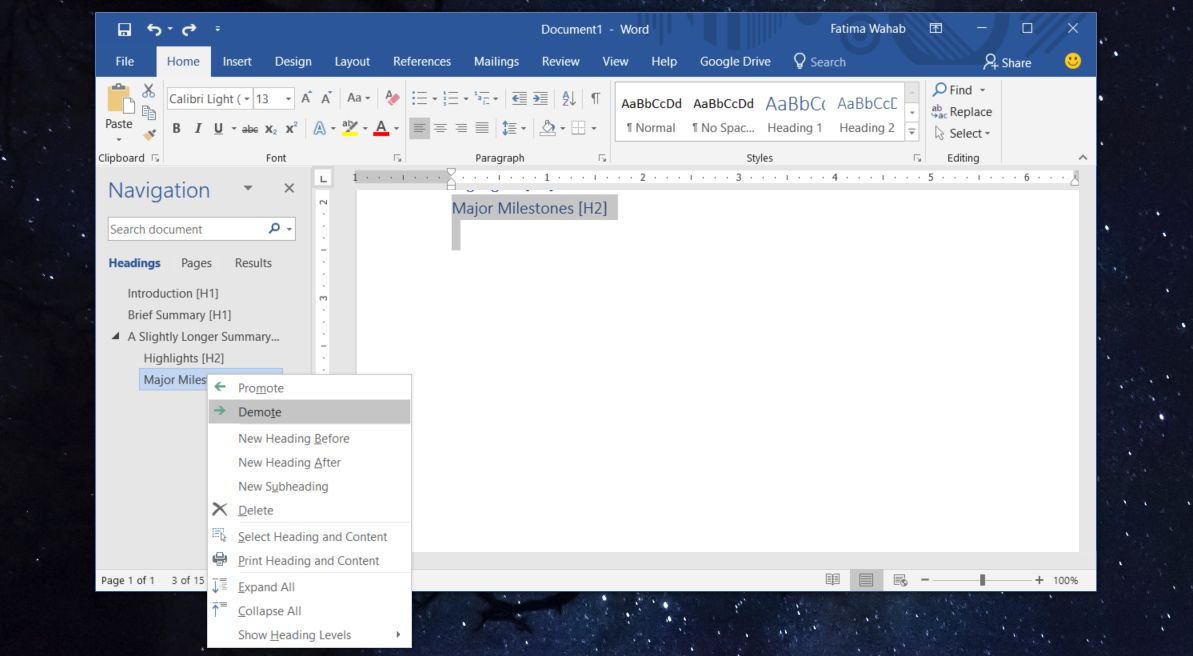

- #MICROSOFT WORD DOCUMENT HEADINGS HOW TO#
- #MICROSOFT WORD DOCUMENT HEADINGS PDF#
- #MICROSOFT WORD DOCUMENT HEADINGS ANDROID#
With ActiveDocument.Sections(1).Headers(wdHeaderFooterFirstPage) This example adds text to the first-page header in the active document. PageNumberAlignment:=wdAlignPageNumberCenter, _ (A separate header is created for the first page.) With ActiveDocument.Sections(1).Headers(wdHeaderFooterPrimary) This example adds centered page numbers to every page in the active document except the first. To return a HeadersFooters collection that represents the footers for the specified section, use the Footers property.

Remarksįor information about returning a single member of a collection, see Returning an object from a collection. SyntaxĮxpression A variable that represents a ' Section' object. Word Styles contain preconfigured headings understood by assistive technology (e.g., Heading 1- Heading 6). For many users, the icons that dot the ribbon at the top of each document are more intimidating than a complex math equation. Use the built-in heading styles to apply uniform heading structure to Word documents. Microsoft Word is an amazingly robust set of tools, but few people ever use more than one or two of its powerful functions.
#MICROSOFT WORD DOCUMENT HEADINGS PDF#
The dialog box talks about creating PDF bookmarks using ‘Headings’.Returns a HeadersFooters collection that represents the headers for the specified section. Making text larger or bolder does not make it a heading in Word. One example is the options available when saving to the PDF format.

#MICROSOFT WORD DOCUMENT HEADINGS HOW TO#
When making the custom heading styles, setting the Outline Level is often (and understandably) overlooked.Īccording to Microsoft you can apply ‘Heading’ styles to fill in the Navigation Pane – but that’s not entirely true. Specifically, How to control spacing and alignment in a numbered list in Microsoft Word shows how to control spacing and alignment and How to number headings in a Word 2016 document shows a simple. This problem is most likely to happen if you’ve created custom heading styles and by-passed the in-built ‘Heading n’ styles.

A Table of Contents can be built without the essential part of the Navigation Pane – the Outline Level. Text selected to be formatted with a heading style 3. (Or, move your cursor to a blank line where you want to type your new heading during the next step.) Figure 2. Select the text you want to turn into a heading. So they should also appear in the Navigation Pane too? The next section explains how to customize the built-in heading styles. Click the heading style you want in the Styles Gallery (such as Heading 1) in the Style group. The document has headings, you can see them in the Table of Contents on right. To create headings by applying heading styles: Click in the paragraph (title or subheading) you want to designate or format as a heading. Then, learn how to customize those styles to your preferred font, font size, alignment, and colo. The Outline view breaks the document down so that each heading and paragraph is represented by a single line. Learn how to create headings in Microsoft Word using styles.
#MICROSOFT WORD DOCUMENT HEADINGS ANDROID#
This feature is available on both Android and iOS Word Apps. Once you create Headings, you should see them in the Headings Pane for quick navigation. Normally the Table of Contents and Navigation Pane are almost the same. Click the Outline button in the Views group. Notice as you click over each style, your text will change so you can see how it will look in your document.


 0 kommentar(er)
0 kommentar(er)
